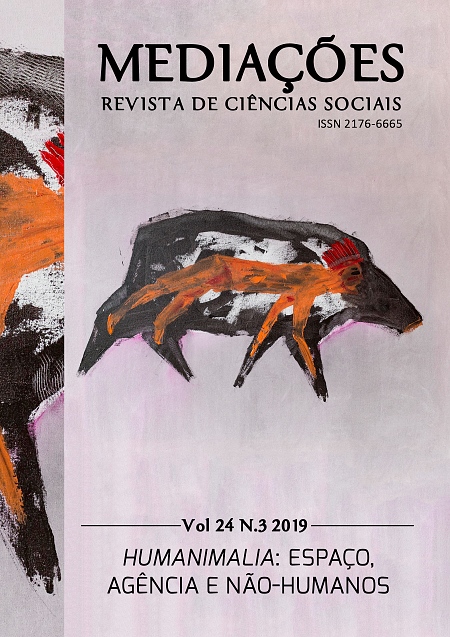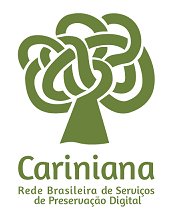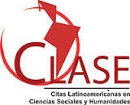The multiple ways of pigeons and their affections: how pigeons and other birds captivate humans
DOI:
https://doi.org/10.5433/2176-6665.2019v24n3p72Keywords:
Humans and animals, Pigeons, Unloved others, Multiple ontologies, AnthropologyAbstract
This article aims to propose a reflection about the captivation of people for some animals, in specific contexts and situations, focuses on the multiple ways of pigeons being and its affection capacity, as well in its distinction towards other birds. These reflections start, mainly, from the unloved others concept and the daily presences to think how far it is the specie that determine some captivation by human beings. Furthermore, once we comprehend the multiple ways of pigeons being and its affection capacity, we can see interactions of these with humans that can be translated by fighting, disgust, control, appreciation, protection and living with. Understanding that these interactions happens in many ways, I shall to think how the unloved others concept may help to think pigeons, once they can be, in specific contexts and situations, a unloved specie by people, but also can be, essentially, in a multiple way.Downloads
References
AGUIAR, T. A demofobia na democracia moderna. Dados: Revista de Ciências Sociais, Rio de Janeiro, v. 54, n. 4, p. 609-650, 2011.
AGUIAR, T. Da importância da noção de "demofobia" para pensar a democracia moderna. In: ENCONTRO ANUAL DA ANPOCS, 33., 2009, Caxambu. Anais [...]. São Paulo: ANPOCS, 2009.
BAKHTIN, M. A imagem grotesca do corpo em Rabelais e suas fontes. In: BAKHTIN, M. A cultura popular na Idade Média e no Renascimento: o contexto de François Rabelais. São Paulo: Hucitec, 1987.
BISMARCK, Julius Von. Some pigeons are more equal than others. Disponível em: http://juliusvonbismarck.com/bank/index.php?/projects/some-pigeons-are-more-equal-than-others/. Acesso em: 26 nov. 2016.
BORSELLINO, L. Animales liminales en la urbe: espacios, resistencia y convivencia. Revista Latinoamericana de Estudios Criticos Animales, Buenos Aires, año 2, v. 1, 2015.
BRASIL. Lei nº 9.605, de 12 de fevereiro de 1998. Dispõe sobre as sanções penais e administrativas derivadas de condutas e atividades lesivas ao meio ambiente, e dá outras providências. Brasília: Presidência da República, 1998. Disponível em: http://www.planalto.gov.br/ccivil_03/leis/l9605.htm. Acesso em: 5 jul. 2019.
CÂMARA de Vereadores aprova projeto que proíbe alimentação de pombos em Caxias do Sul. Pioneiro, Porto Alegre, 28 ago. 2013. Disponível em: http://pioneiro.clicrbs.com.br/rs/geral/cidades/noticia/2013/08/camara-de-vereadores-aprova-projeto-que-proibe-alimentacao-de-pombos-em-caxias-do-sul-4250190.html. Acesso em: 24 fev. 2016.
CHARRIERE, Julian. Some pigeons are more equal than others. Disponível em: http://julian-charriere.net/projects/some-pigeons-are-more-equal-than-others. Acesso em: 26 nov. 2016.
CONSELHO FEDERAL DE BIOLOGIA. Resolução CFBIO n. 384 de 12 de dezembro de 2015. Dispõe sobre a atuação do Biólogo no Controle de Vetores e Pragas Sinantrópicas. Diário Oficial da União: Seção 1, 17 dez. 2015. Disponível em: https://www.crbio01.gov.br/legislacao/resolucoes?page=4. Acesso em: 5 jul. 2019.
COUTINHO, J. Extermínio de pombos na Savassi causa indignação e indiferença", Estado de Minas, Belo Horizonte, 11 jan. 2014. Disponível em: http://www.em.com.br/app/noticia/gerais/2014/01/11/interna_gerais,486837/exterminio-de-pombos-na-savassi-causa-indignacao-e-indiferenca.shtml. Acesso em: 14 dez. 2015.
CREADO, E. S. J.; TORRES, C. C. A.; FREITAS, P. L. T. Ambientalismo, tecnociência e espécies emblemáticas: algumas reflexões a partir de elefantes africanos e tartarugas marinhas. In: BEVILAQUA, C. B.; VELDEN, F. V. (Org.). Parentes, vítimas, sujeitos: perspectivas antropológicas sobre relações entre humanos e animais. São Carlos-Curitiba: Editora UFPR-EdUFSCar, 2016, p. 343-374.
DELEUZE, G. Espinosa: filosofia prática. São Paulo: Escuta, 2002.
DELEUZE, G.; GUATTARI, F. Mil platôs: capitalismo e esquizofrenia. São Paulo: Editora 34, 1997. v. 4.
DESCOLA, P. Estrutura ou sentimento: a relação com o animal na Amazônia. Mana, Rio de Janeiro, v. 1, n. 4, p. 23-45, 1998.
DOUGLAS, M. Pureza e perigo: ensaio sobre a noção de poluição e tabu. Rio de Janeiro: Edições 70, 1991.
DUHAIME-ROSS, A. The Verge Review of Animals: the pigeon". The Verge, 13 de dez. 2015. Disponível em: http://www.theverge.com/2015/12/13/9878736/pigeon-review-animals. Acesso em: 24 fev. 2016.
FALCÕES combatem população de pombos na rodoviária da Capital. Correio do Estado, São Paulo, 13 abr. 2015. Disponível em: http://www.correiodoestado.com.br/cidades/campo-grande/falcoes-combatem-populacao-de-pombos-na-rodoviaria-da-capital/244033/. Acesso em: 24 fev. 2016.
FORTANÉ, N.; KECK, F. How biosecurity reframes animal surveillance. Revue d'anthropologie des Connaissances, Grenoble, v. 9, n. 2, 2015.
IGREJA faz abaixo-assinado pelo abate de pombos em Londrina, no Paraná", G1 Norte e Nordeste, Londrina, 26 maio 2014. Disponível em: http://g1.globo.com/pr/norte-noroeste/noticia/2014/05/igreja-faz-abaixo-assinado-pelo-abate-de-pombos-em-londrina-no-parana.html. Acesso em: 25 set. 2015.
JEROLMAK, C. How pigeons became rats: the cultural-spatial logic of problem animals. Social Problems, Oxford, v. 55, n. 1, p. 72-94, 2008.
KIRKSEY, S. E.; HELMREICH, S. The emergence of multispecies ethnography. Cultural Anthropology, Arlington, v. 25, n. 4, p. 545-576, 2010.
LEBON, G. Psicologia das multidões. Lisboa: Edições Roger Delraux, 1980.
LÉVI-STRAUSS, C. Tristes trópicos. São Paulo: Anhembi, 1957.
LIEN, M.; LAW, J. 'Emergent aliens': on salmon, nature, and their enactment. Ethnos, Stockholm, v. 76, n. 1, p. 65-87, 2011.
MAIS DE 100 pombas são encontradas mortas na Serra do RS. G1 Globo, São Paulo, 14 jan. 2016. Disponível em: http://g1.globo.com/rs/rio-grande-do-sul/noticia/2016/01/mais-de-100-pombas-sao-encontradas-mortas-na-serra-do-rs.html. Acesso em: 14 set. 2016.
MOL, A. Política ontológica: algumas ideias e várias perguntas. In: NUNES, J. A.; ROQUE, R. (org.). Objectos impuros: experiências em estudos sociais da ciência. Porto: Edições Afrontamento, 2007. p. 63-75.
NO DISTRITO Federal, homem cria 176 pombos-correio. R7 17. Brasília, 17 maio 2015. Disponível em: www.noticias.r7.com/distrito-federal/no-distrito-federal-homem-cria-176-pombos-correio-17052015. Acesso em: 3 dez. 2015.
ORWELL, G. A revolução dos bichos. São Paulo: Companhia das Letras, 2007.
OVERING, J. Elogio do cotidiano: a confiança e a arte da vida social em uma comunidade amazônica. Mana, Rio de Janeiro, v. 5, n. 1, p. 81-107, 1999.
POMBOS continuam proliferando e são perigosos". A Tribuna, 5 ago. 1994.
PORNE, C. Guarulhos cria multa para quem alimentar pombos em locais públicos. Folha de São Paulo, São Paulo, 31 ago. 2015. Disponível em: http://mural.blogfolha.uol.com.br/2015/08/31/guarulhos-cria-multa-para-quem-alimentar-pombos-em-locais-publicos/. Acesso em: 24 fev. 2016.
POVOLEDO, E. Venice bans pigeon feeding in St. Mark's Square. The New York Times, New York, 8 maio 2008. Disponível em: http://www.nytimes.com/2008/05/08/world/europe/08iht-pigeon.4.12710015.html. Acesso em 26 de setembro de 2015. Acesso em: 14 dez. 2015.
RIBEIRO, D. Robô é instalado para espantar pombos em estação de trem na Escócia. Tech Tudo, São Paulo, 21 mar. 2013. Disponível em: http://www.techtudo.com.br/noticias/noticia/2013/03/robo-e-instalado-para-espantar-pombos-em-estacao-de-trem-na-escocia.html. Acesso em: 24 fev. 2016.
RIBEIRO, E. Garças e pombos reabilitam dois pontos turísticos de Teresina. Meio Norte, [S.l], 19 jan. 2015. Disponível em: http://www.meionorte.com/blogs/efremribeiro/passaros-reabilitam-dois-pontos-turisticos-de-teresina-310403. Acesso em: 14 dez. 2015.
ROSE, D. B.; VAN DOOREN, T. Unloved others: death of the disregarded in the time of extinctions. Australian Humanities Review, Canberra, v. 50, 2011.
SAHLINS, M. Ilhas de História. Rio de Janeiro: Jorge Zahar, 1990.
SILBER, E. Pigeon portraits reveal the city bird's true beauty. Audubon, Nova York, 15 set. 2015. Disponível em: https://www.audubon.org/news/pigeon-portraits-reveal-city-birds-true-beauty. Acesso em: 25 set. 2015.
SINGER, P. Animal liberation. New York: Random House, 1989.
SQUIRES, N. Venice's pigeons dyed red, blue and green. The Telegraphy, 27 ago. 2012. Disponível em: www.telegraph.co.uk/news/worldnews/europe/italy/9501773/Venices-pigeons-dyed-red-blue-and-green.html. Acesso em: 26 set. 2015.
STEWERT, P. Venice to fine tourists who feed pigeons. The Reuter, [S.l.], 30 abr. 2008. http://www.reuters.com/article/us-venice-pigeons-idUSL3070027920080430#mfPwC0cwMLkZbLTT.97. Acesso em: 14 dez. 2015.
VALENTINE, B. Painted pigeons: political commentary or pop street art? Hyperallergic, 25 out. 2012. Disponível em: https://hyperallergic.com/58034/painted-pigeons-political-commentary-or-pop-street-art/. Acesso em: 26 set. 2015.
VELDEN, F. V. Apresentação ao dossiê: animalidades plurais. R@u: Revista de Antropologia da UFSCar, São Carlos, v. 7, n. 1, p. 7-16, 2015.
Downloads
Published
How to Cite
Issue
Section
License
Copyright (c) 2019 Sarah Faria Moreno

This work is licensed under a Creative Commons Attribution 4.0 International License.
Copyright on articles published in Mediações belongs to the author(s): in the case of partial or entire republication of the original publication, we ask author(s) to indicate the original publication in the periodical.
Mediações uses the Creative Commons Attribution 4.0 International license, which allows Open Access, enabling any user to read, download, copy and disseminate its content so long as adequately referenced.
The opinions expressed by the author(s) are their sole responsibility.
































